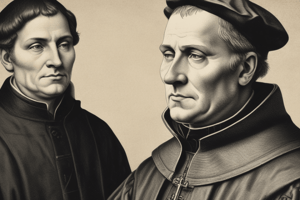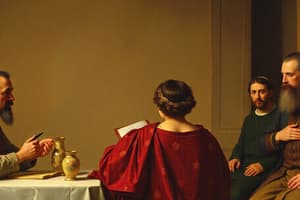Podcast
Questions and Answers
Which of the following best describes the shared foundational beliefs among Catholics, Orthodox Christians, and Protestants?
Which of the following best describes the shared foundational beliefs among Catholics, Orthodox Christians, and Protestants?
- Rejection of the concept of the Holy Trinity.
- Belief in multiple gods with varying roles.
- Acceptance of papal infallibility.
- Belief in one creator God and the Trinity, along with the incarnation, death, and resurrection of Jesus Christ. (correct)
What was a key element of the Protestant Reformation's heritage regarding the accessibility of religious texts for the common people?
What was a key element of the Protestant Reformation's heritage regarding the accessibility of religious texts for the common people?
- Promoting the translation of the Bible into vernacular languages. (correct)
- Maintaining Latin as the sole language for religious texts.
- Restricting religious education to the clergy.
- Focusing solely on artistic expression rather than textual understanding.
What was the significance of Max Weber's work in relation to Protestantism?
What was the significance of Max Weber's work in relation to Protestantism?
- He argued that Protestantism hindered the development of capitalism.
- He established the theological basis for the Council of Trent.
- He explored the connection between Protestant ethics and the spirit of capitalism. (correct)
- He advocated for the return to traditional Catholic practices.
Which theological concept was emphasized to clarify notions of purgatory and the eucharist during the period of religious reforms?
Which theological concept was emphasized to clarify notions of purgatory and the eucharist during the period of religious reforms?
How did the translation of the Bible into vernacular languages impact religious practices?
How did the translation of the Bible into vernacular languages impact religious practices?
What characterized the artistic expressions during the time of anxieties and religious reforms?
What characterized the artistic expressions during the time of anxieties and religious reforms?
What was the significance of 'devotio moderna' during the 15th and 16th centuries?
What was the significance of 'devotio moderna' during the 15th and 16th centuries?
What was Martin Luther's initial action that sparked the Protestant Reformation?
What was Martin Luther's initial action that sparked the Protestant Reformation?
How did Luther's doctrine differ from Catholic beliefs regarding salvation?
How did Luther's doctrine differ from Catholic beliefs regarding salvation?
What was Luther’s view on the role of clergy in relation to individual believers?
What was Luther’s view on the role of clergy in relation to individual believers?
Which factor significantly contributed to the spread of Lutheranism throughout Europe?
Which factor significantly contributed to the spread of Lutheranism throughout Europe?
What distinguishes Calvinism from Lutheranism concerning the concept of grace and salvation?
What distinguishes Calvinism from Lutheranism concerning the concept of grace and salvation?
What was Henry VIII's primary motivation for initiating the English Reformation?
What was Henry VIII's primary motivation for initiating the English Reformation?
What was the main aim of the Puritans during the reign of Elizabeth I?
What was the main aim of the Puritans during the reign of Elizabeth I?
Why do many historians use the term 'Catholic Reformation' instead of 'Counter-Reformation'?
Why do many historians use the term 'Catholic Reformation' instead of 'Counter-Reformation'?
What was the main goal of the Council of Trent?
What was the main goal of the Council of Trent?
How did Erasmus differ from Martin Luther concerning human nature and salvation?
How did Erasmus differ from Martin Luther concerning human nature and salvation?
What role did the Jesuits play during the Catholic Reformation?
What role did the Jesuits play during the Catholic Reformation?
What was the significance of Bible historiée?
What was the significance of Bible historiée?
When it comes to the eucharist, what did the lutherans believe?
When it comes to the eucharist, what did the lutherans believe?
Flashcards
Christianity in the Modern Era
Christianity in the Modern Era
Refers to the spread of Christianity and its various forms in Europe and the New World during the 16th, 17th, and 18th centuries.
Catholicism (Roman Rite)
Catholicism (Roman Rite)
The original branch that separated, leading to the other two branches of Christianity.
Orthodox Christianity
Orthodox Christianity
Progressive distancing that led to a rupture in 1054. (Michel Cérulaire)
Protestantism
Protestantism
Signup and view all the flashcards
Protestant Church
Protestant Church
Signup and view all the flashcards
Protestant Reformation Heritage
Protestant Reformation Heritage
Signup and view all the flashcards
Catholic Reformation Heritage
Catholic Reformation Heritage
Signup and view all the flashcards
Vernacular Bible translations
Vernacular Bible translations
Signup and view all the flashcards
Luther's Bible Translation
Luther's Bible Translation
Signup and view all the flashcards
Music in Lutheran Tradition
Music in Lutheran Tradition
Signup and view all the flashcards
"State of Grace"
"State of Grace"
Signup and view all the flashcards
Two Parallel Reformations
Two Parallel Reformations
Signup and view all the flashcards
Purgatory
Purgatory
Signup and view all the flashcards
Eucharist
Eucharist
Signup and view all the flashcards
The Black Death
The Black Death
Signup and view all the flashcards
Intercession
Intercession
Signup and view all the flashcards
Rejection of "Merit"
Rejection of "Merit"
Signup and view all the flashcards
Individual Piety
Individual Piety
Signup and view all the flashcards
Vernacular Bible
Vernacular Bible
Signup and view all the flashcards
Access to Bible
Access to Bible
Signup and view all the flashcards
Study Notes
Modern Christianity in Europe and the New World (16th-18th Centuries)
- Reformation involved the spread of Christianity and the emergence of diverse Christian denominations
- Expansion into the new world occurred
Introduction
- Christianity fragmented into three branches: Roman Catholicism, Orthodox Christianity, and Protestantism
- Roman Catholicism, practiced with Latin rites, was the original branch that separated over time
- Orthodox Christianity, practiced with Greek rites, experienced a gradual separation that culminated in the schism of 1054, led by Michel Cérulaire
- Protestantism emerged starting in 1517, spearheaded by Martin Luther
- Catholics, Orthodox Christians, and Protestants share core beliefs: one God who is creator, a triune God (Father, Son, Holy Spirit), the incarnation of Jesus, and his death and resurrection, which offer humanity salvation from sin and eternal life
Legacy of Religious Reforms
- Protestant Reformation impacted religion and culture, including literature, arts, and anthropology
- Catholic Reformation affected religion and culture, as well
- The Protestant church has 900 million followers, distributed globally
- Lutherans consists of 65 million people
- Calvinists consists of 50 million people
- Anglicans consists of 70 million people
- Evangelicals consists of 500 million people
Literary, Artistic, and Anthropological Heritage
- Bible was translated into vernacular languages
- Martin Luther translated the Bible into German, which became a standard reference
- Music heritage within the Lutheran tradition encompasses Christian songs
- Johann Sebastian Bach (1685-1750) composed music
- Gospel music
- Protestantism has influenced literacy, political choice (Calvinism in the 15th century), and Max Weber's 1905 work linking Protestant ethics to capitalism
- The Catholic Church uses catechisms from the Council of Trent
- Sermons and funeral orations are part of the literary heritage
- Baroque altarpieces from churches constitute artistic heritage
- The expression "state of grace" is used in media and politics and is derived from a Catholic expression describing readiness to receive divine grace
Reasons for the Reforms
- Parallel reforms emerged with different responses
- Vitality and religious anxieties marked the late Middle Ages
- Vitality was evident during the late Middle Ages
- Mendicant orders, like Franciscans, Dominicans, Carmelites, and Augustinians, were prominent
- Theological concepts: purgatory and eucharist
- Latin Church defined purgatory as an intermediate place after death for purification in the 10th century
- Thomas Aquinas (13th century) taught that the Eucharist maintains the appearance of bread and wine even though transubstantiation occurs
- Seven sacraments are recognized
- Seven deadly sins
- Seven virtues
- Crosses were placed in public
- Flamboyant Gothic period prevailed
- Anxieties marked a time of fears, including crises such as the Black Death of 1348, the Hundred Years' War (1337-1453), the Great Schism (1378-1417), and the Turkish advancement with the fall of Constantinople in 1453
- Expression of anxieties in the arts included the Dance Macabre in 1485 and Matthias Grunewald's Isenheim Altarpiece (1512-1516)
- Lived apprehensions of the apocalypse, concerning individual status, fear of individual and collective judgment after death, and an overall anxious atmosphere
- Cults of intercession developed, corresponding to the veneration of saints; the Virgin Mary was revered as a protector, along with Saint John the Baptist and Saint Michael as the weigher of souls
- Accumulation of meritorious works involved performing "meritorious" acts, such as joining a confraternity, pilgrimages to distant shrines, and having masses read
Gaining Merit in Christianity
- Accumulating merits through acts by Christians in paradise, especially by gaining indulgences
- Indulgences were considered a treasury of merits and credit for all Christians in paradise, granted by the Pope to expiate sins and gain merit
- Demand for indulgences was high in the 14th and 15th centuries
- Derogatory practices and new questions arose regarding indulgences
- A personal relationship with the divine emerged with individual piety
- Bourgeoisie, merchants, and intellectuals sought a more personal piety
- Personal prayer became important
- Rosary prayer and pious reading became common
- Interior dialogue prayer was practiced first among monks, then bishops
- Bible reading in vernacular languages became practiced
- Johannes Gutenberg printed the first Bible around 1455 in Mainz, known as the "42-line Bible"
- Bibles were handwritten in the Middle Ages, and the 42-line Bible resembled them closely
- German Bible was printed in 1466 in Strasbourg by J. Mentel
- Italian Bible was printed in 1471 in Venice by Nicolas Malerni
- French abbreviated Bible was printed in 1473-1474
- First Czech New Testament was printed in 1475
- Dutch Bible was printed in 1477 (Delfe)
- Low German Bible was printed in 1478 in Cologne, Catalan Bible in Venice
- Czech Bible was printed in 1488 in Venice
- Illustrated Bibles with images became supports for prayer and meditation
- Glosses are explanatory notes aiding readers in understanding specific words
- Access to the Bible in the 15th century was widely accepted due to high demand
- Church men became enthusiastic, seeking opportunities to trace linguistic sources in the texts
Humanism and Reform
- Humanists, like Erasmus, translated the New Testament from Greek originals
- Modern enthusiasm for ancient works marked the end of the Middle Ages
- Spiritual renewal and modern devotion (devotio moderna) were sought
- The Netherlands and Germany were most affected by devotio moderna
- Denunciation of abuses and desire for reform regarding abuses included the lifestyle of Renaissance popes between 1450 and 1540 in that they lived like kings, were from wealthy families, and had costly demands on the Church
- Absenteeism of clerics occurred
- Ignorance of the majority of the faithful and clergy was present
- The faithful passively attend mass without real knowledge or pedagogy
- Clergy exhibited behavioral problems, with actions straying away from the theoretical conduct of priests, including simony, greed, drunkenness, concubinage, sexual abuse, and violence
- Pierre Valdo (died c. 1217) was a merchant from Lyon who advocated direct access to the Bible for laypersons and rejected the cult of saints; his followers were known as the Vaudois
- John Wyclif (died c. 1384), an English academic, wanted to make the Bible available to the faithful and developed a highly egalitarian conception of the Church, virtually without clergy, defending the primacy of grace; his ideas influenced the Lollards
- Jan Hus (died 1415), a theologian from the University of Prague, defended Wyclif's ideas, advocated for the translation of the Bible into Czech, and denounced indulgences; he was burned as a heretic
- The council of 1517 aimed to denounce abuses
- Reform sought to address spiritual unease, as the Church acted as an intermediary between believers and God
Martin Luther and Lutheranism
- There was a question if a more direct, personal relationship with God should be sought
- Questioning whether God saves, or if people save themselves through good deeds.
- Theological proposition in 1517: Luther's reformation involved "disputation" to foster argumentation
- Academic debate regarding indulgences
- Ninety-five theses were made
- October 31, 1517: act n°1 of the Protestant Reformation
- Martin Luther (1483-1546) was a path of liberation
- Luther was a vigorous spirit, tormented soul, and theologian
- Luther made a liberating discovery: "justification by faith"
- Luther broke with the papacy and called the Pope the Antichrist
- A bull in late 1520 called for Luther's excommunication
- A new faith/return to the sources was elaborated
Differences Between Lutheranism and Catholicism
- "Universal priesthood" exists in Lutheranism, where there is no clergy mediating between the faithful and God, and "ministers" are not ordained and can marry
- Monastic vows and regular clergy are no longer present
- Only two sacraments remain (Baptism and Eucharist) instead of seven
- Mass/Eucharist is celebrated in the vernacular (German).
- Lutheran Eucharist commemorated Christ's last meal with his disciples; it is not a renewal of the sacrifice on the cross
- Bread and wine become the body and blood of Christ during the Lutheran mass, but they remain bread and wine; this is known as "consubstantiation", unlike the Catholic belief in "transubstantiation"
- Lutheran faithful commune in "both forms," both bread and wine
- Virgin Mary and saints are not worshipped
- Purgatory is rejected, and prayer for the deceased is not practiced
- The dead are in God's hands
- Lutheranism spread mainly in Northern Germany, Scandinavia, and the Baltic countries
- Princes, kings, and the local elite supported Lutheranism
- Printing and translation of the Bible into the vernacular facilitated the spread
- Monarchs supported by adopting Lutheranism by rulers like Christian III in Denmark and Gustav Vasa in Sweden
Lutheran Church Organization
- Churches became national churches under the authority of sovereigns without a pope or centralized hierarchy
- Parishes were led by pastors trained in Protestant universities
- Religious education allowed individuals to read the Bible
- Reasons to adhere to the Reformation: to return to the Bible (sola scriptura), salvation by faith (sola fide), and rejection of Catholic abuses
- Political motivations included the independence of princes from the Pope and confiscation of Church properties
- Social and economic motivations included reducing ecclesiastical influence and promoting literacy
Diversification of Protestantism
- Reformers from Switzerland and Jean Calvin (1509-1564) helped diversify
- Calvin was the second patriarch of the Reformation
- Grace in Protestantism is not for everyone but can be given or denied based on merit, unlike in Catholicism
- Max Weber's "The Protestant Ethic and the Spirit of Capitalism" (1905) linked success in capitalism to a sign of special grace
- Churches in Switzerland, the Rhine Valley, France (Huguenots), the Netherlands, and Scotland (Presbyterians) have Calvinist church organizations
- Calvinist churches are commonly called "reformed churches," using the term "reformed" in a more specific sense than "Protestant
Studying That Suits You
Use AI to generate personalized quizzes and flashcards to suit your learning preferences.





